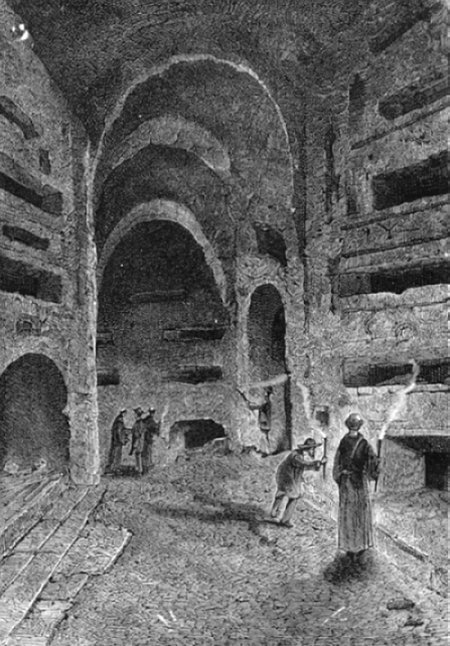Catacombs
Today, catacombs. The University of Houston's College of Engineering presents this series about the machines that make our civilization run, and the people whose ingenuity created them.
I've been reading a remarkable old volume on Antiquities from 1882 — almost a thousand pages with wonderful romantic illustrations. What really gets my attention is the long section on Tombs and Catacombs. How far from our thinking this lies!
Tune into all the fine educational TV shows, and you'll see an endless march of sunlit programs on excavating tombs, X-Raying mummies, finding ancient relics. Computers reconstruct the face of an ancient Mongol princess or an Egyptian aristocrat. We learn what grains were used in their last bowl of gruel. The ancient dead become wonderfully demystified and human.
Now this nineteenth-century view of ancient burial sites offers a glimpse into the hidden reaches below the surface of our souls, as well as below the surface of Earth. No X-ray images here; this is pure Indiana Jones — death swathed in mystery.
So much attention was given to dramatizing death during the nineteenth century. Funerals were major productions. The departed was laid out and placed on view — often photographed in the coffin. The hearse was drawn by black horses, bedecked in black plumes. Now this old book reminds us how much has changed, as we try (perhaps vainly) to replace grieving with celebrations of life.
Think about the way the word catacomb drifts in modern usage. You and I might use it to describe any underground system of tunnels. In fact it means an underground cemetery, and the vast catacombs of Rome form the centerpiece of this book. The author claims that they run for nine hundred miles, and house seven million dead.
Well, those are huge exaggerations — high by at least factors of ten. He writes, "Woe to the man whose boldness leads him to venture alone into these dark depths." Enter them without a guide, he tells us, and you'll certainly become lost and die in them.
He dwells on inscriptions, both from the early Romans and the Christians who followed them: "Primitius in peace: a most valiant martyr after many torments," or "Navarina ... a soul sweet as honey."
He provides drawings of coffins, corpses, mummies, and the precious things buried along with them. We can practically hear the sputtering torches, as the smell of rancid smoke mixes with the odor of death and decay. These are places where ghosts live — places where Orpheus, or Aeneas, descended to the River Styx to negotiate with the boatman Charon.

You and I have left these dark celebrations of death, yet this book reads like the storyboard for any of the spate of movies now trying to recapture it. As Tomb-Raider Lara Croft and Indiana Jones pursue greater mysteries than can be found above the ground, they echo the comic strips of an era much closer to the nineteenth century. They, like this old book, remind us that death is shrouded in mystery that we will not easily shrug off.
I'm John Lienhard, at the University of Houston, where we're interested in the way inventive minds work.
(Theme music)
L. W. Yaggy, and T. L. Haines, Museum of Antiquity: A Description of Ancient Life ..., New York: Standard Publishing House, 1882, "Tombs and Catacombs," pp. 833-910.
